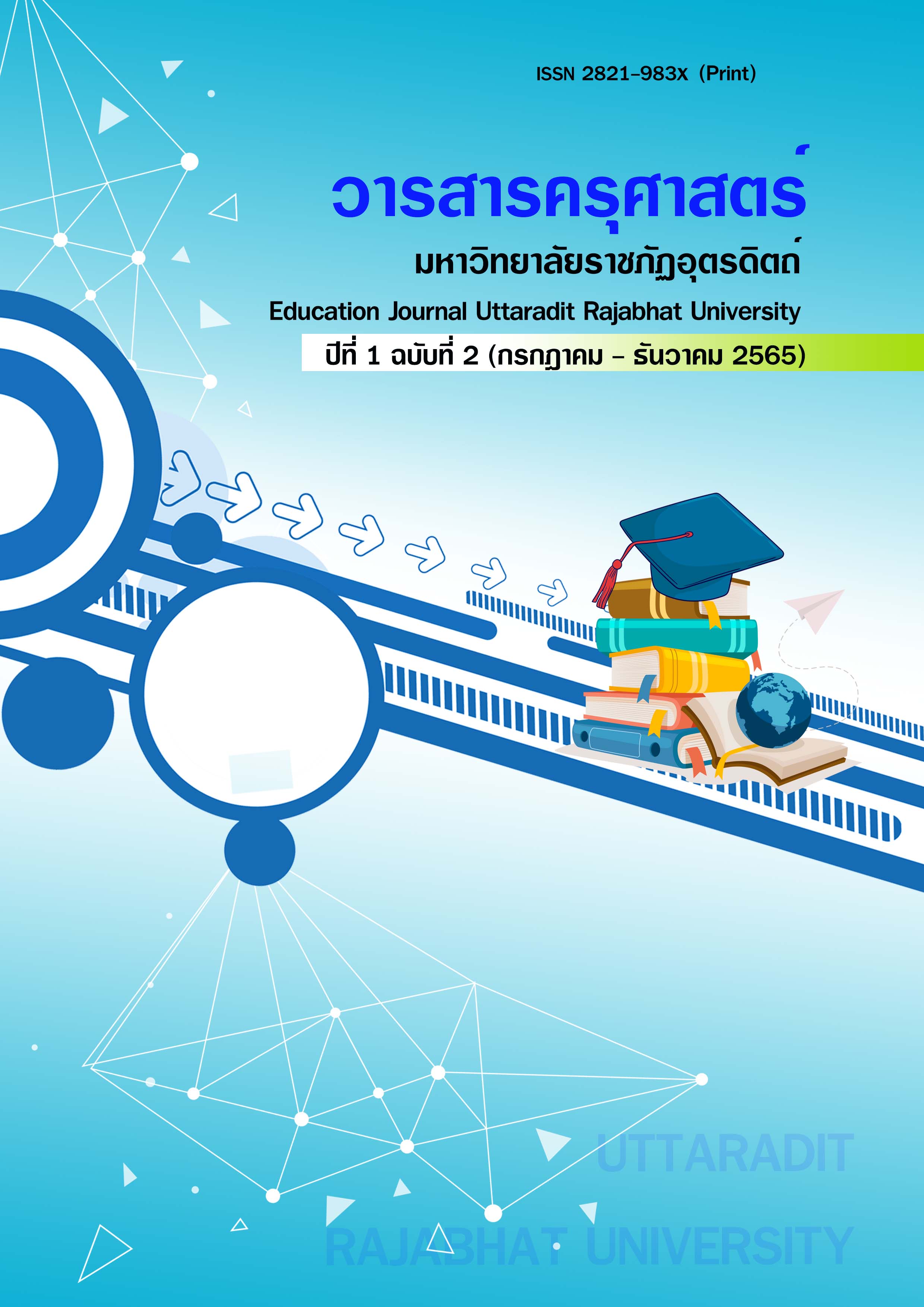The Development of Academic Achievement in Physics Subject on Work and Energy by Organizing Collaborative Learning with Jigsaw Techniques and the Creation of Video Media of Mathayom 4 Students in Thaplapracha u-this School
Main Article Content
Abstract
This research was aimed to 1) compare the learning achievement in Physics subject on Work and Energy between before and after the cooperative learning with jigsaw technique together with the creation of video media, 2) compare the learning achievement in Physics subject on Work and Energy between a common learning management and a cooperative learning management using jigsaw technique and creating video media, and 3) study the students' satisfaction towards the collaborative learning management using the jigsaw technique together with the creation of video media on work and energy. The samples used in the research were selected by simple random method. It was divided into a control group and experimental group. The former consisted of 26 students in Mathayomsuksa 4, Room 2, that received the common learning management, while the latter consisted of 26 students in Mathayomsuksa 4, Room 1, that received the cooperative learning management using jigsaw technique and creating video media. The research tools consisted of cooperative learning management plan using jigsaw techniques, an achievement test, and a satisfaction assessment form.
The results showed that 1) an achievement in physics course on work and energy after collaborative learning with jigsaw technique and creating video media was significantly higher than before collaborative learning with jigsaw technique and creating video media with p value less than 0.05. 2) the experimental group achievement was also significantly higher than that of control group with p value less than 0.05. 3) Students were satisfied with the collaborative learning with jigsaw techniques combined with the creation of a video media on work and energy of students in Grade 4 is at the highest level (=4.84)
Article Details

This work is licensed under a Creative Commons Attribution-NonCommercial-NoDerivatives 4.0 International License.
Faculty of Education Journal Uttaradit Rajabhat University It is a medium for disseminating research results. Academic work Any opinions expressed in the article are solely the personal opinions of the author. Faculty of Education Uttaradit Rajabhat University and the editorial team does not necessarily have opinions that are consistent with those expressed in the article in any way. and is not considered the responsibility of the Faculty of Education Uttaradit Rajabhat University and editorial team
References
กรมวิชาการ. (2546). การจัดสาระการเรียนรูกลุ่มสาระการเรียนรู้วิทยาศาสตร์ตามหลักสูตรการศึกษาขั้นฐาน พุทธศักราช 2544. กรุงเทพฯ: คุรุสภาลาดพร้าว.
กัญญารัตน์ นามสว่าง และคณะ. (2564). ผลการจัดการเรียนรู้แบบร่วมมือเทคนิคจิ๊กซอว์ ที่มีต่อผลสัมฤทธิ์ทางการเรียน และการคิดวิเคราะห์ของนักเรียนชั้นมัธยมศึกษาปีที่ 2. วารสารศึกษาศาสตร์, 8: (1) ชลบุรี: มหาวิทยาลัยบูรพา.
ชนม์นิภา เพชรรุ่ง และคณะ. (2562). การศึกษาผลสัมฤทธิ์การอ่านภาษาอังกฤษเพื่อความเข้าใจโดยใช้เทคนิคการสอนแบบ Jigsaw สำหรับนักเรียนชั้นมัธยมศึกษาปีที่ 1 โรงเรียนน้ำริดวิทยา อำเภอเมือง จังหวัดอุตรดิตถ์. รายงานสืบเนื่องจากการประชุมวิชาการระดับชาติ ครุศาสตร์ศึกษาครั้งที่ 2 วันที่ 21-22 มีนาคม 2562. พิษณุโลก: มหาวิทยาลัยราชภัฏพิบูลสงคราม.
นริศรา เจะมุสา. (2556). ผลของการจัดการเรียนรู้แบบร่วมมือเทคนิคจิ๊กซอว์ ที่มีต่อทักษะทางสังคมและผลสัมฤทธิ์ทางการเรียนวิชาวิทยาศาสตร์ของนักเรียนชั้นมัธยมศึกษาปีที่ 5 โรงเรียนเมืองนครศรีธรรมราช. (วิทยานิพนธ์). นครศรีธรรมราช: มหาวิทยาลัยราชภัฏนครศรีธรรมราช.
เบญจภรณ์ รอดสุขเจริญ. (2560). การพัฒนาชุดกิจกรรมการเรียนรู้แบบร่วมมือเทคนิค Jigsaw เรื่อง คอมพิวเตอร์เบื้องต้น สำหรับชั้นมัธยมศึกษาปีที่ 1. (วิทยานิพนธ์). พิษณุโลก: มหาวิทยาลัยนเรศวร.
เปี่ยมสุข ไชยผา. (2554). การจัดการเรียนรู้แบบร่วมมือโดยใช้เทคนิคจิ๊กซอว์ เพื่อพัฒนาผลสัมฤทธิ์ทางการเรียนเรื่องกรด เบส. (วิทยานิพนธ์). อุบลราชธานี: มหาวิทยาลัยอุบลราชธานี.
ภพ เลาหไพบูลย์. (2542). แนวการสอนวิทยาศาสตร์ (ฉบับปรับปรุง). (พิมพ์ครั้งที่ 3). กรุงเทพฯ: ไทยวัฒนาพานิช.
รัชนี ทาเหล็ก. (2556). ผลการจัดการเรียนรู้แบบร่วมมือด้วยเทคนิคจิ๊กซอว์ เรื่อง เส้นขนาน ที่มีต่อความสามารถในการคิดวิเคราะห์ ของนักเรียนชั้นมัธยมศึกษาปีที่ 2. (วิทยานิพนธ์). กรุงเทพฯ:มหาวิทยาลัยศรีนครินทรวิโรฒ.
ศักดิ์ดา ชูศรี. (2538). การพัฒนาสื่อวีดิทัศน์เพื่อการศึกษาด้วยตนเอง เพื่อเทคนิคการใช้โสตทัศนอุปกรณ์. รายงานพัฒนาเทคนิคศึกษา 8, 20 (ตุลาคม – ธันวาคม 2539)
ศิริพร ศรีจันทะ และประดิษฐ์ วิชัย. (2560). การศึกษาผลสัมฤทธิ์ทางการเรียนด้วยการจัดกิจกรรมการเรียนรู้ด้วยกลุ่มร่วมมือแบบจิ๊กซอว์ รายวิชาการพัฒนาหลักสูตร ของนักศึกษาระดับปริญญาตรี. การประชุมหาดใหญ่วิชาการระดับชาติและนานาชาติ ครั้งที่ 8 วันที่ 22 มิถุนายน 2560. สงขลา : มหาวิทยาลัยหาดใหญ่.
สถาบันส่งเสริมการสอนวิทยาศาสตร์และเทคโนโลยี. (2548). การจัดสาระการเรียนรู้กลุ่มวิทยาศาสตร์ หลักสูตรการศึกษาขั้นพื้นฐาน. กรุงเทพฯ: สถาบันส่งเสริมการสอนวิทยาศาสตร์และเทคโนโลยี.
สมวุฒิ ชัยกิจ. (2548). การเปรียบเทียบผลสัมฤทธิ์ทางการเรียนวิชาฟิสิกส์และเจตคติวิชาวิทยาศาสตร์ของนักเรียนชั้นมัธยมศึกษาปีที่ 4 ที่ได้รับการสอนโดยการจัดการเรียนแบบร่วมมือด้วยเทคนิคแบ่งกลุ่ม คละผลสัมฤทธิ์และการสอนตามปกติ. (วิทยานิพนธ์). นครสวรรค์: มหาวิทยาลัยราชภัฏนครสวรรค์.
สุวัฒน์ นิยมค้า.(2531). ทฤษฎีและทางปฏิบัติในการสอนวิทยาศาสตร์แบบสืบเสาะหาความรู้. กรุงเทพฯ: โรงพิมพ์เจเนอรัลบุคส์เซ็นเตอร์.
ไสว ฟักขาว. (2544). The Meaningful Learning Approach เอกสารประกอบการฝึกอบรมเชิงปฏิบัติการครูวิทยาศาสตร์. เสนอที่จังหวัดระยอง
อิสรีย์ น้อยมิ่ง. (2557). การศึกษาผลสัมฤทธิ์การเรียน เรื่อง การสร้างคำในภาษาไทยของนักเรียนชั้นมัธยมศึกษาปีที่ 1 ที่จัดการเรียนรู้ด้วยเทคนิคจิ๊กซอว์ (Jigsaw) ร่วมกับบทเรียนคอมพิวเตอร์มัลติมีเดีย. (วิทยานิพนธ์). นครปฐม: มหาวิทยาลัยศิลปากร.
Corporation for Public Broadcasting. (2004). Television goes to school: The impact of video on
Student learning in formal education. Available : http://www.cpb.org/stations/reports/ ivgoestoschool/
Mayer. R E. (2001). Multimedia learning. New York: Cambridge University Press.
Slavin E. Robert. (1995). Cooperative Learning Theory, Research, and Practice. 2nd ed. Massachusett : Allyn and Bacon.


